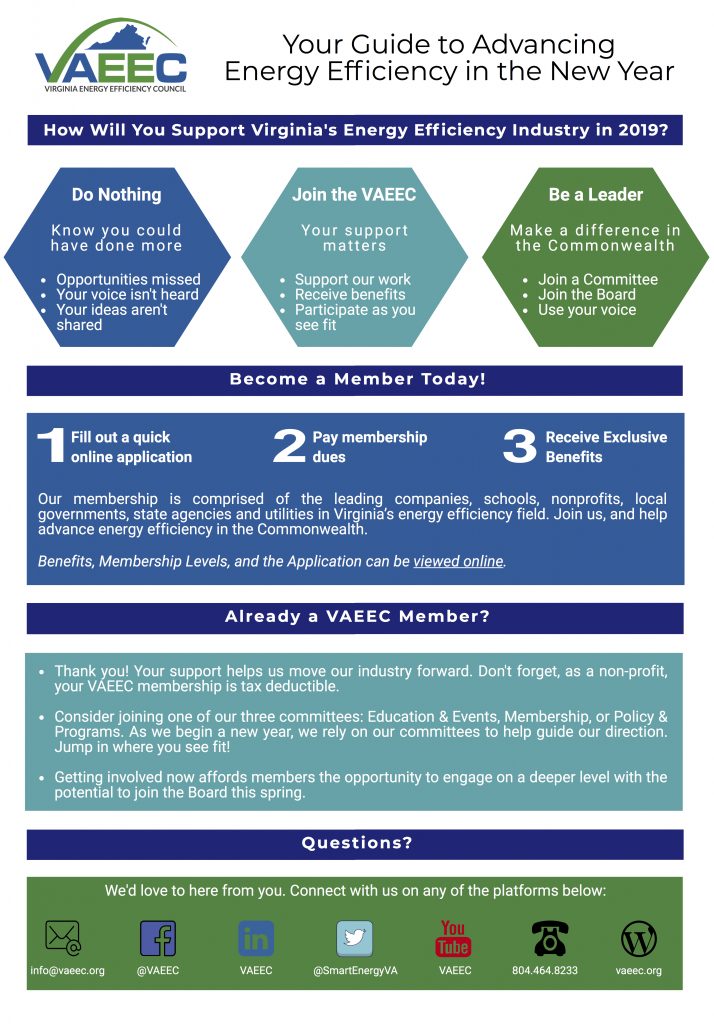 2019 has just started, which means it’s time to ring in those new year resolutions! What better way than to boost your support of energy efficiency. If you are not already a member of VAEEC, your first step is to join. It’s really quick and, as a member, you receive benefits like access to exclusive resources such as legislative updates, networking events, the membership directory, and our job-opening board. If you are already a member, you can use your voice and get involved with the Board or one of our three advisory committees. Help us move the Virginia Commonwealth even further with Energy Efficiency this year!
2019 has just started, which means it’s time to ring in those new year resolutions! What better way than to boost your support of energy efficiency. If you are not already a member of VAEEC, your first step is to join. It’s really quick and, as a member, you receive benefits like access to exclusive resources such as legislative updates, networking events, the membership directory, and our job-opening board. If you are already a member, you can use your voice and get involved with the Board or one of our three advisory committees. Help us move the Virginia Commonwealth even further with Energy Efficiency this year!
There’s no better time for making lifestyle changes and setting goals than the start of a new year. As 2019 approaches, we’re taking some of the most common resolutions and adding an energy-efficient twist. Not only will they help conserve energy, but they will also save you money for years to come.
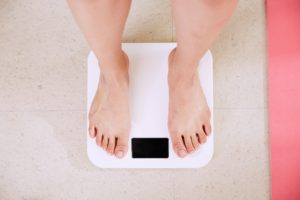 The typical weight loss resolution, although beneficial to health, can be a big consumer of energy during the winter months. The average treadmill uses between 600 and 700 watts of energy, and aging ones can consume 30 percent more energy than brand new machines. Instead, use Elliptical machines and stationary bikes, as they are generally self-powered or use six to seven times less energy than treadmills. Also, try to partake in outdoor workouts such as running, biking, or walking or performing at-home workouts without equipment when temperatures are extremely low.
The typical weight loss resolution, although beneficial to health, can be a big consumer of energy during the winter months. The average treadmill uses between 600 and 700 watts of energy, and aging ones can consume 30 percent more energy than brand new machines. Instead, use Elliptical machines and stationary bikes, as they are generally self-powered or use six to seven times less energy than treadmills. Also, try to partake in outdoor workouts such as running, biking, or walking or performing at-home workouts without equipment when temperatures are extremely low.
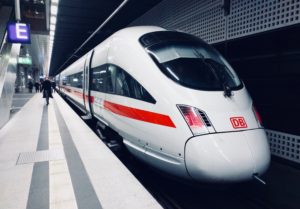 Travel, while another popular resolution, is an expensive goal. Yet it can be made more affordable with a few simple steps. Before planning a trip, getting your car inspected and fixing any serious maintenance problems can improve your gas mileage by up to 40% and help you save more than $1,300 a year. If your destination is far away, consider taking a bus or a train instead of flying, as these modes of transportation are generally more energy-efficient and can be more affordable.
Travel, while another popular resolution, is an expensive goal. Yet it can be made more affordable with a few simple steps. Before planning a trip, getting your car inspected and fixing any serious maintenance problems can improve your gas mileage by up to 40% and help you save more than $1,300 a year. If your destination is far away, consider taking a bus or a train instead of flying, as these modes of transportation are generally more energy-efficient and can be more affordable.
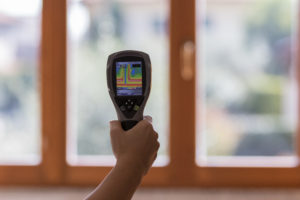 One resolution that should be on your list this year is to make energy-efficient improvements around your house or apartment. Energy-efficient upgrades improve your home’s comfort and value. Even better, they pay for themselves over time, and the addition of advanced technology, investments, and DIY projects could mean even more savings. To figure out what improvements will give you the best bang for your buck, consider getting your home inspected by a professional home energy auditor. Often they’ll do a blower door test and thermographic imaging to pinpoint exactly where energy is escaping. Several VAEEC members offer residential energy auditing services, such as the Fifth Fuel, Local Energy Alliance Program (LEAP), Think Little, and Viridiant.
One resolution that should be on your list this year is to make energy-efficient improvements around your house or apartment. Energy-efficient upgrades improve your home’s comfort and value. Even better, they pay for themselves over time, and the addition of advanced technology, investments, and DIY projects could mean even more savings. To figure out what improvements will give you the best bang for your buck, consider getting your home inspected by a professional home energy auditor. Often they’ll do a blower door test and thermographic imaging to pinpoint exactly where energy is escaping. Several VAEEC members offer residential energy auditing services, such as the Fifth Fuel, Local Energy Alliance Program (LEAP), Think Little, and Viridiant.
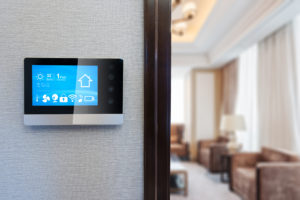 Energy auditors provide suggestions on which upgrades would be most beneficial for your home. Suggestions could include sealing air leaks with caulk and weatherstripping, adding insulation throughout, and window treatments such as energy-saving storm panels, window shutters, or blinds. This can also include installing a programmable or wifi thermostat, such as the ones offered by VAEEC members Honeywell and Nest, to control household temperatures and scheduling. These improvements provide fast return on investment.
Energy auditors provide suggestions on which upgrades would be most beneficial for your home. Suggestions could include sealing air leaks with caulk and weatherstripping, adding insulation throughout, and window treatments such as energy-saving storm panels, window shutters, or blinds. This can also include installing a programmable or wifi thermostat, such as the ones offered by VAEEC members Honeywell and Nest, to control household temperatures and scheduling. These improvements provide fast return on investment.
You don’t have to take on your new year’s resolutions alone; they are easier and more effective when executed with others. Education and awareness are crucial components of successful energy efficiency practices. Serving as that liaison for family and friends will help them adopt such practices while also reinforcing your own actions and providing an opportunity to spend more time with one another. Monitoring progress together can be a fun activity or a competitive game. Resulting savings can even be put towards a fun outing.
As you can see, there are plenty of potential resolutions and goals, big and small, that can make a huge difference in your utility bills and wallets. Educate your loved ones, stay focused, and let’s make 2019 the most energy efficient year yet!
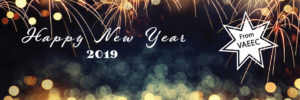
 As fall comes to a close and winter’s cold temperatures approach, it is essential to implement energy efficiency tips and technologies in your home to keep you and your family warm without the dreaded spike in your energy bills. There are many tips and tricks below that can be accomplished through simple, quick installations or practices.
As fall comes to a close and winter’s cold temperatures approach, it is essential to implement energy efficiency tips and technologies in your home to keep you and your family warm without the dreaded spike in your energy bills. There are many tips and tricks below that can be accomplished through simple, quick installations or practices.
Lower the thermostat to save up to 10% on utility bills.
While you may be tempted to increase the thermostat as it gets colder outdoors, lowering your thermostat by 7-10 degrees during colder months can save as much as 10 percent a year on utility bills.
Upgrade your technology.
Replacing your home’s older thermostat with a programmable one can lead to big savings by allowing you to manage energy usage when you’re not home. Other technologies, such as installing automatic timers, motion sensors, dimmers, and solar cells, are also great at conserving energy and are valuable tools that can be used year-round.
Use power strips, install light timers, take advantage of LED technology.
With the holiday season upon us, it’s even more important to be aware of energy consumption. From plugging in decorative lights to playing Christmas carols, a household can see a utility bill increase of $100 this time of year. To overcome this financial burden, consider using a power strip and/or install a light timer to control when the lights turn on and off. Another simple change is to invest in LED lighting. Not only do LED lights consume 70 percent less energy than conventional incandescent light strands, they also last much longer.
 Make smart choices in the kitchen.
Make smart choices in the kitchen.
Holiday baking and meal preparation can also increase your electricity and gas usage this time of year. Using the right-sized pots on stove burners can save about $36 annually for an electric range or $18 for gas. Also, using the oven light to check on dish’s progress instead of opening the door will prevent heat loss and wasted energy.
Turn down your water heater.
Did you know that water heating can account for 14 to 25 percent of the total energy used in a home? Reducing the preset water temperature and using cold water for laundry are easy ways to decrease those utility bills.
Maintain and check your home’s systems.
Another easy way to keep heat inside is to simply maintain and check your home’s systems. Proper maintenance of your HVAC system, including cleaning or replacement, can help keep those heating costs down. Giving that 30% of your home energy bill is a result of distribution losses when air moves from your furnace to the vents, changing or cleaning your filters regularly will help increase the efficiency while helping you clean up on your energy bills.
 With the proper precautions, anybody can enjoy a fun, warm holiday season without incurring the dreaded utility bill increases. These energy efficient life hacks are easy and can save a great deal of money, leaving room for you to treat yourself and your loved ones this holiday season.
With the proper precautions, anybody can enjoy a fun, warm holiday season without incurring the dreaded utility bill increases. These energy efficient life hacks are easy and can save a great deal of money, leaving room for you to treat yourself and your loved ones this holiday season.
In addition to our Fall Meeting and Awards Luncheon, VAEEC had a busy fall season partnering with our members to host site visits for legislators to see energy efficiency “in action” in their districts. Similarly to the site visits we did last year, we wanted to highlight for decision-makers how impactful policy decisions they make can be for their constituents.
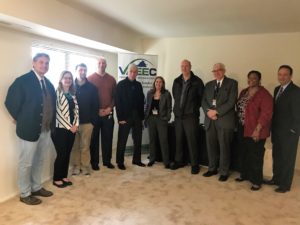
Rosedale Manor Tour
In Falls Church, we partnered with VAEEC member, the Local Energy Alliance Program (LEAP) to take Senator Richard “Dick” Saslaw on a tour of Rosedale Manor, a 96-unit affordable housing complex owned by the Fairfax County Redevelopment and Housing Authority (FCRHA). The complex underwent a weatherization retrofit, including new attic insulation and installation of efficient LED light bulbs and faucet aerators through Energy Share, a Dominion Energy weatherization program funded through shareholder money, which was recently expanded under the Grid Transformation and Security Act of 2018 (SB 966).
It’s not often that you can see concrete, positive results of recent legislation with your own eyes. As part of the tour, Senator Saslaw walked through an apartment where the weatherization upgrades had been made and heard from Fairfax County officials about the projected cost-savings from these upgrades.
Additionally, VAEEC partnered with Viridiant again this year to host Senator Glen Sturtevant for a tour of the Virginia Supportive Housing, Studios II residences in South Richmond. Formerly a budget motel, this facility is a certified EarthCraft Multifamily residence, which houses formerly homeless individuals and provides them with temporary or permanent housing depending on individual needs.
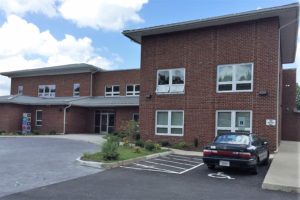
Studios II Tour
Studios II has a variety of features that create a healthy and safe living environment for its tenants. The building envelope was tightened, outdated through-wall HVAC systems were replaced with ductless mini-splits, and solar panels were installed on the new flat roof to reduce the building’s energy load. Widening the existing building to increase the square footage of each unit to approximately 300 square feet ensured that each unit was able to meet accessibility requirements.
Stay tuned. VAEEC plans to host more of these legislative site visits throughout 2019. If you would like to get involved, contact info@vaeec.org.
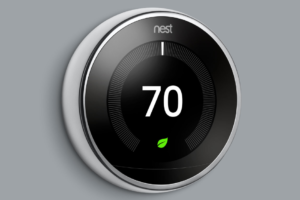 Last year, VAEEC member Nest partnered with the Colorado Energy Office to launch a pilot project for their Weatherization Assistance Program (WAP) to test the incremental energy savings Nest Learning Thermostats have on natural gas furnaces. One WAP agency installed Nest thermostats in 250 homes, approximately half of the homes that were weatherized from May 2016 throughout December 2017, to see its effects on gas savings. The primary purpose was to assess how well the technology functioned for the weatherization program and its clients in terms of installation logistics, acceptance, and operation. A treatment group received standard weatherization services plus a Nest thermostat and a control group received just the standard weatherization services.
Last year, VAEEC member Nest partnered with the Colorado Energy Office to launch a pilot project for their Weatherization Assistance Program (WAP) to test the incremental energy savings Nest Learning Thermostats have on natural gas furnaces. One WAP agency installed Nest thermostats in 250 homes, approximately half of the homes that were weatherized from May 2016 throughout December 2017, to see its effects on gas savings. The primary purpose was to assess how well the technology functioned for the weatherization program and its clients in terms of installation logistics, acceptance, and operation. A treatment group received standard weatherization services plus a Nest thermostat and a control group received just the standard weatherization services.
Groups were assigned based on the following criteria:
- owner-occupied
- single family home — site built or manufactured/mobile home
- heated with natural gas provided by Xcel Energy
- only one thermostat in home
- customer was willing to have a Nest thermostat installed
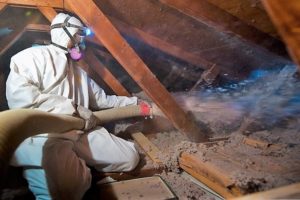 Homes that received both WAP services and Nest thermostats saw a reduction of total gas use from 18% to 11%. Using the Weatherization Assistant National Energy Audit Tool (NEAT), the Nest thermostats were found to be very cost-effective, having Savings to Investment Ratios between 4.3-8.6. For homes that received a furnace replacement, the WAP+Nest group saved an average of 31% of total gas use (39% of heating use) compared to 14% savings (18% of heating use) for standard WAP homes. The incremental savings averaged 169 therms (17% of total, 22% of heating) in these homes. One of the more surprising results was that out of the clients that received a Nest thermostat, 81% had WiFi in the home indicating WiFi as a less significant factor on savings.
Homes that received both WAP services and Nest thermostats saw a reduction of total gas use from 18% to 11%. Using the Weatherization Assistant National Energy Audit Tool (NEAT), the Nest thermostats were found to be very cost-effective, having Savings to Investment Ratios between 4.3-8.6. For homes that received a furnace replacement, the WAP+Nest group saved an average of 31% of total gas use (39% of heating use) compared to 14% savings (18% of heating use) for standard WAP homes. The incremental savings averaged 169 therms (17% of total, 22% of heating) in these homes. One of the more surprising results was that out of the clients that received a Nest thermostat, 81% had WiFi in the home indicating WiFi as a less significant factor on savings.
It should be noted that because there was no untreated control group in the analysis, the savings results are not adjusted for any trends in gas use beyond weather adjustment. This doesn’t affect the estimated saving from Nest, but it may affect the absolute levels of savings shown.
Overall, there was a strong correlation between the installation of the Nest thermostat and savings. Clients that received a Nest thermostat in addition to standard weatherization services saved an extra 58 therms of gas per year compared to clients that just received standard weatherization services. The total incremental savings equated approximately 7% of total gas use and 9% of gas heating. Based on these experiences, it appears that around half of WAP clients could be ideal candidates to receive Nest thermostats with their WAP treatments.
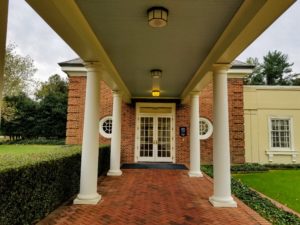 On November 14th the Virginia energy efficiency community gathered for the VAEEC Fall Meeting and Awards Luncheon at the University of Richmond Jepson Alumni Center. Without the contributions of our generous sponsors, we would not have been able to make this event possible. A big thank you to our sponsors and event attendees for making the event a great success!
On November 14th the Virginia energy efficiency community gathered for the VAEEC Fall Meeting and Awards Luncheon at the University of Richmond Jepson Alumni Center. Without the contributions of our generous sponsors, we would not have been able to make this event possible. A big thank you to our sponsors and event attendees for making the event a great success!
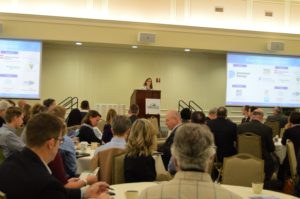
Registration and networking began at 10 am, followed by an opening presentation from Executive Director, Chelsea Harnish. After welcoming attendees she gave a quick recap of some of VAEEC’s 2018 accomplishments and updates. Next came a presentation from keynote speaker, Journey Williams, Vice President of Smart Building Technologies. Journey covered the following before transitioning to audience Q+A:
- Intro to Smart Building Technologies, LLC and how they are helping buildings become more energy efficient
- “Tour” of District Center, one of the most advanced smart tech buildings in our area (555 12th St NW building in D.C.), including what makes this building unique and how it utilizes smart technologies to reduce and manage energy consumption.
Afterward, participants attended one of two breakout sessions: Energy Efficiency Startups or Health and Energy Efficiency.
Energy Efficiency Startups panel: The Commonwealth Energy fund strategically invests in companies with market-ready products to take the next step into broader commercialization. This panel focused on three companies working on energy-efficient technologies in the realms of building automation, LED lighting, hot water tanks, and thermal storage. Speakers included Arnoud van Houten (Aquanta), Roger Whyte (LiteSheet Solutions), and Serene Almomen (Senseware), and Marco Rubin (Center for Innovative Technology) was the panel moderator. Arlington County was the session sponsor.
Health and Energy Efficiency panel: Energy efficiency measures have the potential to improve not only the comfort of buildings but building health as well. However, these measures can lead to moisture and air quality problems if not implemented correctly. Panelists discussed the links between energy efficiency and building health and addressed the impacts of energy efficiency construction for Low-Income Housing Tax Credit (LIHTC) housing and EarthCraft Virginia rehabs. Speakers included Mark Jackson (Community Housing Partners) and Dona Huang (VA Dept. of Health), and Wilson Ratliff (LEAP) moderated. Virginia Housing Alliance and the Virginia Poverty Law Center sponsored this session.
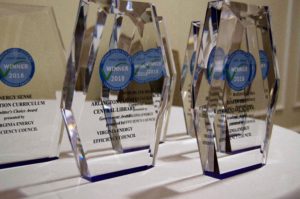 Based on member feedback, we decided to incorporate this year’s Awards Ceremony into the Fall Meeting agenda, instead of having it as an evening event proceeding the Fall Meeting. After a plated lunch, we recognized 12-Virginia based projects or programs in the Academic, Commercial, Government, and Residential categories, as well as the first every Committee’s Choice Award. For info on each winning project or program, visit our 2018 Awards page.
Based on member feedback, we decided to incorporate this year’s Awards Ceremony into the Fall Meeting agenda, instead of having it as an evening event proceeding the Fall Meeting. After a plated lunch, we recognized 12-Virginia based projects or programs in the Academic, Commercial, Government, and Residential categories, as well as the first every Committee’s Choice Award. For info on each winning project or program, visit our 2018 Awards page.
The second breakout session proceeded the Awards Luncheon, where participants attended one of the following panels: Efficient Homes or Strategic Electrification.
Efficient Homes panel: Recently there have been many updates in the realm of residential energy efficiency in Virginia. Panelists shared the latest smart technologies making homes more efficient, provided an update on the Virginia residential building code, and reviewed the findings of the Virginia DOE Field Study report. The speakers included Sean Evenson-Shanely (Viridiant) and Andrew Grisby (VA-REA), and the session was sponsored by the Southeast Energy Efficiency Alliance (SEEA).
Strategic Electrification panel: The grid is undergoing a major transformation, with strategic or beneficial electrification at the epicenter. Panelists discussed applications of beneficial electrification in the residential sector as well as how Virginia is using Volkswagen settlement funds to build electric vehicle infrastructure throughout the Commonwealth. John Semmelhack (Think Little) and Angela Conroy (DEQ) were the two speakers, and Wesley Holmes (SEEA) moderated the panel. SEEA sponsored this session.
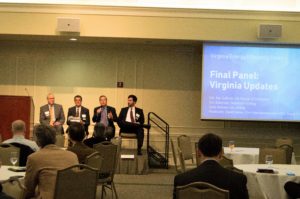 After the breakout session, attendees enjoyed refreshments during the Networking and Snack break before heading into the last panel of the day. The Final Panel focused on energy efficiency updates in Virginia. Speakers included Del. Rip Sullivan (Virginia House of Delegates), John Warren (VA DMME), and Eric Bateman (Dominion Energy). VAEEC Board Chair, David Steiner (D + R International) moderated. Topics covered included the newly released Virginia Energy Plan, the Grid Modernization and Transportation bill (SB 966), and other legislative and regulatory updates.
After the breakout session, attendees enjoyed refreshments during the Networking and Snack break before heading into the last panel of the day. The Final Panel focused on energy efficiency updates in Virginia. Speakers included Del. Rip Sullivan (Virginia House of Delegates), John Warren (VA DMME), and Eric Bateman (Dominion Energy). VAEEC Board Chair, David Steiner (D + R International) moderated. Topics covered included the newly released Virginia Energy Plan, the Grid Modernization and Transportation bill (SB 966), and other legislative and regulatory updates.
The event closed with VAEEC announcing the winners of our membership raffles. The winner for our 2018 New Member raffle was the Fifth Fuel, and Abby Johnson won the Member Recruitment raffle. Congratulations! To be considered for next year’s raffles, you/your organization can join the VAEEC, or current members can recruit new members. New members must join at the $250 level or higher.
Mark your calendars! We hope to see everyone at our Spring 2019 Meeting on Thursday, May 9th in Richmond.
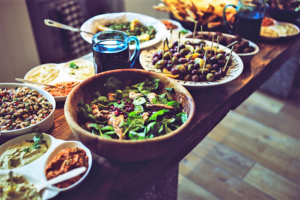 It’s the holiday season, and with Thanksgiving quickly approaching, families will gather to give thanks and celebrate over delicious foods. It’s easy to forget about energy consumption when surrounded by your loved ones or swept up in the chaos of the holidays. However, it’s easy for energy bills to creep up during this time of year due to increased cooking and hosting guests. The good news is, there are simple tips and tricks that can be applied to keep your energy use in check.
It’s the holiday season, and with Thanksgiving quickly approaching, families will gather to give thanks and celebrate over delicious foods. It’s easy to forget about energy consumption when surrounded by your loved ones or swept up in the chaos of the holidays. However, it’s easy for energy bills to creep up during this time of year due to increased cooking and hosting guests. The good news is, there are simple tips and tricks that can be applied to keep your energy use in check.
If hosting guests for a Thanksgiving feast, here are some surefire tips to keep your energy costs down:
- Turn the thermostat down ahead of time. Both the heat from the oven and body temperatures will increase the temperature of your house.
- Add weather stripping to all exterior doors to prevent air leaks and keep cold air out. This will help keep your house warm without having to raise the thermostat.
- Use LED lights. LED lights use at least 75% less energy than their incandescent counterparts, and they even offer dimmable options. Not only do dimmers provide ambiance to mealtime, but every time a bulb’s brightness is reduced by 10%, you double its lifespan.
- Speaking of lighting, make it a habit to turn off all lights in unoccupied rooms.
- Use the microwave instead of the oven whenever possible. Microwaves use less than half of the power of a typical oven, making them both more efficient and faster.
- When a microwave just won’t do, it is recommended to use a gas grill rather than the oven to roast. Grills burn cleaner and cook a lot quicker.
- If you do have to use an electric oven, avoid the temptation to open your oven door to check on your food. Each time it is opened the temperature drops by 25 degrees.
- Additionally, cook as much of your meal as you can at one time. Even foods with differing cooking temperatures can be cooked together at one temperature. A 25 degrees Fahrenheit difference in either direction will still produce good results while saving energy.
- Utilize a cooler with ice instead of the fridge. This will help keep cold air from constantly escaping the fridge when used by a lot of people. It will also free up space for all those scrumptious leftovers!
- Refrain from placing hot foods immediately into the fridge; wait for foods to cool down so the fridge doesn’t have to run harder to counteract the excess heat.
- When it’s time for cleanup, refrain from using your oven’s self-cleaning cycle unless absolutely necessary. Minor splatters and spills should be able to be removed with a damp cloth. If you do have to use the self-cleaning feature, start the cycle immediately following cooking when the oven is still warm. Alternatively, wait until after peak hours when the cost of electricity is at its lowest.
Are you traveling instead of hosting? Here are some ways to be efficient as you travel.
- Unplug “vampire” electronics and turn off lights before leaving home.
- Don’t pay to heat an empty house. Either turn down your thermostat or use the “vacation” mode to avoid unnecessary heating costs.
- Driving? Check your tire pressure before hitting the road. Underinflated tires can both be dangerous and lead to increased fuel consumption.
- Additionally, attempt to stay within the speed limit to help your vehicle maintain optimal fuel economy. Once you exceed 50 mph, your gas mileage decreases quickly.
These life-hacks are simple, yet instrumental in reducing your energy consumption and saving you money. Consider these while spending time with family and educate them on simple ways to conserve money this Thanksgiving. And remember, Thanksgiving is just the start of the holiday season. Implement these tips to celebrate energy efficiency all season long. Happy holidays!

Last week, the VAEEC staff and Board headed over to Christiansburg for a Board meeting hosted by Community Housing Partners. While there, we were fortunate enough to be given a tour of their award-winning CHP Energy Solutions Research and Training Center. The 12,600 sq. ft. Training Center “brings building science training into the twenty-first century”. Labs are equipped with custom-designed props that give students controlled, hands-on experience.
Our tour began with a viewing of A Tale of Weatherization at Grandma’s House, a video depicting how heat, air, and moisture work together to impact your home’s overall comfort and performance. Next, Anthony Cox walked us through a simulation of “Grandma’s House”. Using a model, we learned about Stack Effect by watching it take place. As we watched air enter the crawlspace, we saw it work its way up the house, pressurizing the upper floors. Since hot air rises, the heat and moisture in the crawlspace are forced upwards, increasing the humidity throughout the entire “house”. By simply “sealing” the attic space, we observed a reduction in the amount of air entering the crawlspace. The “house” reached optimal performance when both the attic and crawlspace were “sealed” and an Energy Recovery Ventilation system was replicated. It was fun to observe the impact of weatherization practices right before our eyes!
Next, Mark Jackson lead VAEEC staff and Board on a quick tour of the rest of the facility. This included the House of Pressure, the Heating and Air Conditioning Lab, the Diagnostic House, and multiple props.
- The House of Pressure is a nationally recognized prop developed by CHP’s Anthony Cox that visually demonstrates home performance testing through pressure diagnostics. Since it’s creation in 2002, training centers and community and technology colleges in 43 states and Canada have purchased it. The House of Pressure has also been used at conferences and trainings around the Country, such as the Department of Energy’s weatherization conferences.
- The Heating and Air Conditioning Lab allows students the ability to conduct combustion gas testing, draft testing, equipment efficiency, air flow diagnostics, and more.
- The Diagnostic House is set up for students to gain hands-on experience with air sealing, blower door testing, duct leakage, ventilation, and pressure diagnostics.
- Available props located throughout the Training Center include Dense Packing, Large Air Sealing, Gas Furnaces and Domestic Water Heaters, replicas of single family homes, and a manufactured home.
The CHP Energy Solutions’ Research and Training Center provides students with an environment to learn a whole-house approach to building science, weatherization, and other building performance improvements through hands-on training. If you find yourself in Christiansburg, I highly recommend scheduling a tour. If you are interested in any of CHP’s online or in-person training classes for you or your employees, check out their website.
Keep an eye on our social media! We will be sharing some of the videos we took during the tour soon.
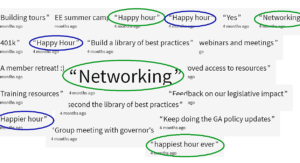
Last Spring, we asked VAEEC members what additional benefits they would like included in their membership. The results were clear. Our members are looking for more networking opportunities. That’s why we paired up with RVA Green Drinks to host a Richmond-area happy hour.
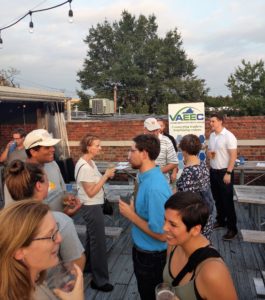 The event proved successful as approximately 30 green business and energy efficiency professionals showed up to meet, mingle, learn about energy efficiency, and soak up the sun on Postbellum‘s rooftop deck.
The event proved successful as approximately 30 green business and energy efficiency professionals showed up to meet, mingle, learn about energy efficiency, and soak up the sun on Postbellum‘s rooftop deck.
Thank you to everyone who came out. We enjoyed catching up with our members and meeting new people interested in Virginia’s energy efficiency sector. We might be a little biased, but we think it was one of the “happiest hours” yet!
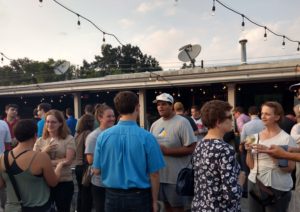 For our members outside of the Richmond-area, we want to include you too. Let us know if you would like to partner to co-host a happy hour event in your area by emailing info@vaeec.org.
For our members outside of the Richmond-area, we want to include you too. Let us know if you would like to partner to co-host a happy hour event in your area by emailing info@vaeec.org.
 There has been an increase in C-PACE activity and progress across the Commonwealth in the past few months, including several localities taking steps to enact their own program. Learn about these updates and resources by reading below, or by listening to a recording of our September webinar, C-PACE in Virginia: Resources Available to Localities.
There has been an increase in C-PACE activity and progress across the Commonwealth in the past few months, including several localities taking steps to enact their own program. Learn about these updates and resources by reading below, or by listening to a recording of our September webinar, C-PACE in Virginia: Resources Available to Localities.
Localities Moving Forward
Arlington County: The pipeline of projects is growing, and in a milestone for the program one was recently reviewed with capital providers to determine funding interest.
City of Fredericksburg: Staff is currently drafting a C-PACE ordinance, and a project is already in line to utilize C-PACE once a program is launched.
Fairfax County: In June, the Fairfax County Board of Supervisors Environmental Committee directed staff to write an ordinance. Staff will develop and submit a draft C-PACE ordinance to be considered by the Environmental Committee during their February 2019 meeting.
Loudoun County: Back in January of this year, the Loudoun County Board of Supervisors voted to direct staff to develop a C-PACE program structure, evaluate options for program administration, and draft an ordinance. In July, the Board reconvened and staff recommended the development of a C-PACE ordinance that would utilize a third-party program administrator for services such as billing and collection of loan payments and allow the County to enforce special assessment liens in the case of defaults.
Other localities looking to move forward with developing a C-PACE program include the cities of Alexandria, Charlottesville, Norfolk, and Roanoke, and the counties of Albemarle, Spotsylvania, and Stafford.
Resources Available to Virginia Localities
Several resources have been recently released to assist localities with the development of C-PACE programs, including case studies, model ordinances, program guidelines, and an RFP template.
Model Ordinances:
- Arlington County has their Ordinance posted to the Arlington C-PACE website for anyone to view.
- Earlier this year, the VAEEC released a Virginia Model Ordinance for localities to use. This document was commissioned following input and review from a wide variety of C-PACE experts and incorporates key factors we consider to be crucial to implementing an effective C-PACE program.
- The Virginia PACE Authority, or VPA, used the Virginia Model Ordinance to create an updated and abbreviate Ordinance that localities can use.
Mid-Atlantic PACE Alliance (MAPA) Resources and Regional Toolkit: MAPA has a variety of resources available on their website. This includes fact-sheets, such as What is C-PACE and Frequently Asked Questions. Additionally, there are several case studies highlighting projects in Washington D.C. and Maryland.
As part of its mission to accelerate the development and utilization of C-PACE in the Mid-Atlantic region, MAPA has released a Regional Toolkit. The toolkit provides best practices specific to this region and guidance and resources that streamline efforts to develop and launch a C-PACE program.
RFPs for Program Administration:
- A template has been created to help localities craft their Request for Proposals (RFP) for Program Administrator services.
- Along with several resources included on their website, Arlington County has the option for Virginia localities to ride their contract with their program administrator, SRS. This step eliminates the need for a locality to go through their own RFP process for a Program Administrator.
To learn more about C-PACE, be sure to check out vaeec.org/pace or contact Jessica Greene at jessica@vaeec.org.
 2019 has just started, which means it’s time to ring in those new year resolutions! What better way than to boost your support of energy efficiency. If you are not already a member of VAEEC, your first step is to join. It’s really quick and, as a member, you receive benefits like access to exclusive resources such as legislative updates, networking events, the membership directory, and our job-opening board. If you are already a member, you can use your voice and get involved with the Board or one of our three advisory committees. Help us move the Virginia Commonwealth even further with Energy Efficiency this year!
2019 has just started, which means it’s time to ring in those new year resolutions! What better way than to boost your support of energy efficiency. If you are not already a member of VAEEC, your first step is to join. It’s really quick and, as a member, you receive benefits like access to exclusive resources such as legislative updates, networking events, the membership directory, and our job-opening board. If you are already a member, you can use your voice and get involved with the Board or one of our three advisory committees. Help us move the Virginia Commonwealth even further with Energy Efficiency this year!
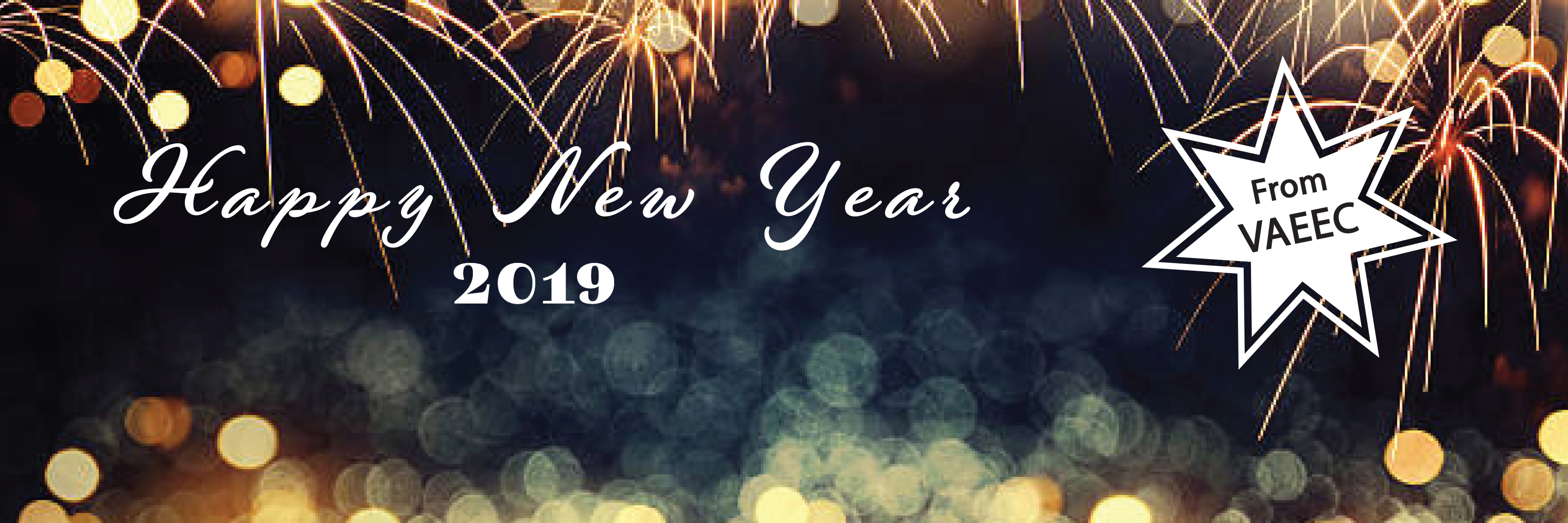
 The typical weight loss resolution, although beneficial to health, can be a big consumer of energy during the winter months. The average treadmill uses between 600 and 700 watts of energy, and aging ones can consume 30 percent more energy than brand new machines. Instead, use Elliptical machines and stationary bikes, as they are generally self-powered or use six to seven times less energy than treadmills. Also, try to partake in outdoor workouts such as running, biking, or walking or performing at-home workouts without equipment when temperatures are extremely low.
The typical weight loss resolution, although beneficial to health, can be a big consumer of energy during the winter months. The average treadmill uses between 600 and 700 watts of energy, and aging ones can consume 30 percent more energy than brand new machines. Instead, use Elliptical machines and stationary bikes, as they are generally self-powered or use six to seven times less energy than treadmills. Also, try to partake in outdoor workouts such as running, biking, or walking or performing at-home workouts without equipment when temperatures are extremely low.  Travel, while another popular resolution, is an expensive goal. Yet it can be made more affordable with a few simple steps. Before planning a trip, getting your car inspected and fixing any serious maintenance problems can improve your gas mileage by up to 40% and help you save more than $1,300 a year. If your destination is far away, consider taking a bus or a train instead of flying, as these modes of transportation are
Travel, while another popular resolution, is an expensive goal. Yet it can be made more affordable with a few simple steps. Before planning a trip, getting your car inspected and fixing any serious maintenance problems can improve your gas mileage by up to 40% and help you save more than $1,300 a year. If your destination is far away, consider taking a bus or a train instead of flying, as these modes of transportation are  One resolution that should be on your list this year is to make energy-efficient improvements around your house or apartment. Energy-efficient upgrades improve your home’s comfort and value. Even better, they pay for themselves over time, and the addition of advanced technology, investments, and DIY projects could mean even more savings. To figure out what improvements will give you the best bang for your buck, consider getting your home inspected by a professional home energy auditor. Often they’ll do a blower door test and thermographic imaging to pinpoint exactly where energy is escaping. Several VAEEC members offer residential energy auditing services, such as the
One resolution that should be on your list this year is to make energy-efficient improvements around your house or apartment. Energy-efficient upgrades improve your home’s comfort and value. Even better, they pay for themselves over time, and the addition of advanced technology, investments, and DIY projects could mean even more savings. To figure out what improvements will give you the best bang for your buck, consider getting your home inspected by a professional home energy auditor. Often they’ll do a blower door test and thermographic imaging to pinpoint exactly where energy is escaping. Several VAEEC members offer residential energy auditing services, such as the  Energy auditors provide suggestions on which upgrades would be most beneficial for your home. Suggestions could include sealing air leaks with caulk and weatherstripping, adding insulation throughout, and window treatments such as energy-saving storm panels, window shutters, or blinds. This can also include installing a programmable or wifi thermostat, such as the ones offered by VAEEC members
Energy auditors provide suggestions on which upgrades would be most beneficial for your home. Suggestions could include sealing air leaks with caulk and weatherstripping, adding insulation throughout, and window treatments such as energy-saving storm panels, window shutters, or blinds. This can also include installing a programmable or wifi thermostat, such as the ones offered by VAEEC members 
 As fall comes to a close and winter’s cold temperatures approach, it is essential to implement energy efficiency tips and technologies in your home to keep you and your family warm without the dreaded spike in your energy bills. There are many tips and tricks below that can be accomplished through simple, quick installations or practices.
As fall comes to a close and winter’s cold temperatures approach, it is essential to implement energy efficiency tips and technologies in your home to keep you and your family warm without the dreaded spike in your energy bills. There are many tips and tricks below that can be accomplished through simple, quick installations or practices.  Make smart choices in the kitchen.
Make smart choices in the kitchen. With the proper precautions, anybody can enjoy a fun, warm holiday season without incurring the dreaded utility bill increases. These energy efficient life hacks are easy and can save a great deal of money, leaving room for you to treat yourself and your loved ones this holiday season.
With the proper precautions, anybody can enjoy a fun, warm holiday season without incurring the dreaded utility bill increases. These energy efficient life hacks are easy and can save a great deal of money, leaving room for you to treat yourself and your loved ones this holiday season.

 Last year, VAEEC member
Last year, VAEEC member  Homes that received both WAP services and Nest thermostats saw a reduction of total gas use from 18% to 11%. Using the Weatherization Assistant National Energy Audit Tool (NEAT), the Nest thermostats were found to be very cost-effective, having Savings to Investment Ratios between 4.3-8.6. For homes that received a furnace replacement, the WAP+Nest group saved an average of 31% of total gas use (39% of heating use) compared to 14% savings (18% of heating use) for standard WAP homes. The incremental savings averaged 169 therms (17% of total, 22% of heating) in these homes. One of the more surprising results was that out of the clients that received a Nest thermostat, 81% had WiFi in the home indicating WiFi as a less significant factor on savings.
Homes that received both WAP services and Nest thermostats saw a reduction of total gas use from 18% to 11%. Using the Weatherization Assistant National Energy Audit Tool (NEAT), the Nest thermostats were found to be very cost-effective, having Savings to Investment Ratios between 4.3-8.6. For homes that received a furnace replacement, the WAP+Nest group saved an average of 31% of total gas use (39% of heating use) compared to 14% savings (18% of heating use) for standard WAP homes. The incremental savings averaged 169 therms (17% of total, 22% of heating) in these homes. One of the more surprising results was that out of the clients that received a Nest thermostat, 81% had WiFi in the home indicating WiFi as a less significant factor on savings.  On November 14th the Virginia energy efficiency community gathered for the VAEEC Fall Meeting and Awards Luncheon at the University of Richmond Jepson Alumni Center. Without the contributions of our generous sponsors, we would not have been able to make this event possible. A big thank you to our sponsors and event attendees for making the event a great success!
On November 14th the Virginia energy efficiency community gathered for the VAEEC Fall Meeting and Awards Luncheon at the University of Richmond Jepson Alumni Center. Without the contributions of our generous sponsors, we would not have been able to make this event possible. A big thank you to our sponsors and event attendees for making the event a great success!
 Based on member feedback, we decided to incorporate this year’s Awards Ceremony into the Fall Meeting agenda, instead of having it as an evening event proceeding the Fall Meeting. After a plated lunch, we recognized 12-Virginia based projects or programs in the Academic, Commercial, Government, and Residential categories, as well as the first every Committee’s Choice Award. For info on each winning project or program, visit our
Based on member feedback, we decided to incorporate this year’s Awards Ceremony into the Fall Meeting agenda, instead of having it as an evening event proceeding the Fall Meeting. After a plated lunch, we recognized 12-Virginia based projects or programs in the Academic, Commercial, Government, and Residential categories, as well as the first every Committee’s Choice Award. For info on each winning project or program, visit our 
 It’s the holiday season, and with Thanksgiving quickly approaching, families will gather to give thanks and celebrate over delicious foods. It’s easy to forget about energy consumption when surrounded by your loved ones or swept up in the chaos of the holidays. However, it’s easy for energy bills to creep up during this time of year due to increased cooking and hosting guests. The good news is, there are simple tips and tricks that can be applied to keep your energy use in check.
It’s the holiday season, and with Thanksgiving quickly approaching, families will gather to give thanks and celebrate over delicious foods. It’s easy to forget about energy consumption when surrounded by your loved ones or swept up in the chaos of the holidays. However, it’s easy for energy bills to creep up during this time of year due to increased cooking and hosting guests. The good news is, there are simple tips and tricks that can be applied to keep your energy use in check. 
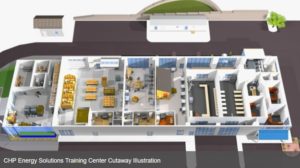
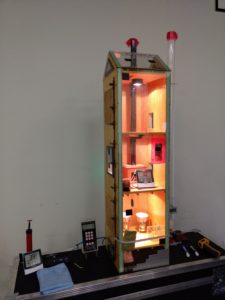
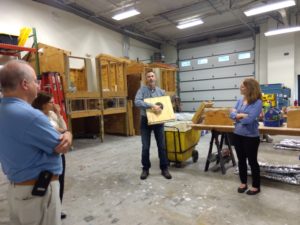
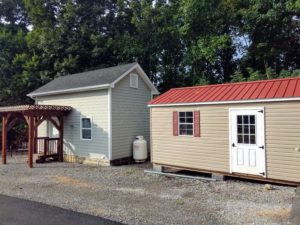

 The event proved successful as approximately 30 green business and energy efficiency professionals showed up to meet, mingle, learn about energy efficiency, and soak up the sun on
The event proved successful as approximately 30 green business and energy efficiency professionals showed up to meet, mingle, learn about energy efficiency, and soak up the sun on  For our members outside of the Richmond-area, we want to include you too. Let us know if you would like to partner to co-host a happy hour event in your area by emailing
For our members outside of the Richmond-area, we want to include you too. Let us know if you would like to partner to co-host a happy hour event in your area by emailing  There has been an increase in C-PACE activity and progress across the Commonwealth in the past few months, including several localities taking steps to enact their own program. Learn about these updates and resources by reading below, or by listening to a recording of our September webinar,
There has been an increase in C-PACE activity and progress across the Commonwealth in the past few months, including several localities taking steps to enact their own program. Learn about these updates and resources by reading below, or by listening to a recording of our September webinar,